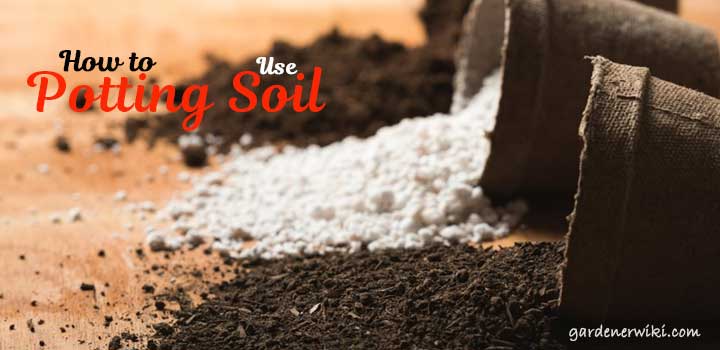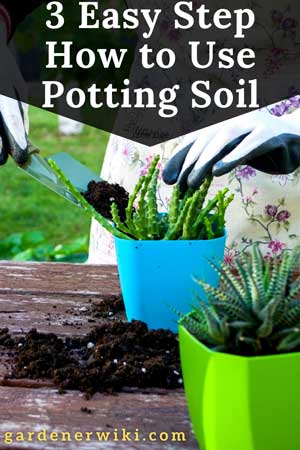It is best not to treat these potted plants with typical garden soil. Often, the garden soils can contain weeds and are heavy. Thus, potting soils are a great solution that generates healthy vegetation and saves up money as well.
Now you might ask how to use potting soil? Well, we’ve answered that question in detail here and touched upon how to make potting soil for indoor plants. So, read on to know more.

What Is Potting Soil?
Before diving deeper, let us first learn what potting soil is. Potting soil is a mixture of various components that facilitates plant growth.
With a balance of proper nutrients, these mixes prevent soil from getting very compacted, which sometimes suffocates roots and hinders the flow of nutrients and water.
A premium potting soil with its capacity to withstand moisture will be fluffy and lightweight.
Potting soils come in various types – from all-purpose mixes to more specialized ones. You can add basic components like fertilizers, inorganic natural materials, and other additives to potting soil.
Types of Potting Mixes
One important thing you should keep note of is the different growing stages and appropriate soil for each.
The germination stage, growth stage, and harvesting stage; are the 3 stages of a plant. It’s better if you manage the soil for each stage accordingly.
The types of potting mixes also depend on the type of plant. Overall, the types are:
- Seed Starting Mix
If you are growing the plants from seeds or cuttings, this is going to be the appropriate option. These mixes are formulated especially for seedlings. The review section has two such types of seed starting mixes.
- All-Purpose Mix
On the other hand, if you plan to work with many plants in different stages, you can opt for the all-purpose mixes. These can suit any growing plants as well as seeds, but they do come with a higher price.
How to Make Potting Soil at Home
Commercial potting soils are easy to work with. You only need to shovel a pack in a pot, plant your favorite plant, and that’s it!
But homemade things work wonders, always! The same goes for potting soil. Come up with your own potting soil to grow more beautiful and healthier plants.
Prepare them in big batches to preserve for later use.
Ingredients:
- Peat Moss
It is used as it does not decompose easily and is a stable product. Without adding much weight, the peat moss can fill up spaces.
- Coir Fiber
It is almost similar to peat moss as it fantastically blends with other components. Neutral, the coir fiber lacks the need to balance pH.
- Perlite
It can retain moisture up to 3 to 4 times its weight. When exposed to heat, the perlite expands.
- Sand
As it adds weight and enhances drainage, sand can be considered a vital part of the potting soil. You can especially use it for succulent plants and cacti.
- Limestone
It is a way of balancing the pH of the potting soil. You can readily find limestone in stores.
- Fertilizers
A blend of fertilizers, especially those from manures or animal by-products, can be used to mix an excellent potting soil.
- Compost
It boasts a healthy amount of nutrients and beneficial microbes. If you want to boost your plant’s growth, adding compost is essential.
Step-by-step Guide
Here’s the step-by-step process on how to make potting soil.
Step 1: Prepare an Organic Blend
Add 2 cups of rock phosphate, 1/4th cup of kelp meal, ½ cup bone meal, and two cups of greensand.
Step 2: Add Ingredients
Mix around 6-8 gallons of peat moss, or instead, use the coir fiber. Add perlite of about 5 gallons. Blend with compost manure of 6 gallons.
If you have chosen peat moss, squeeze in a 1/4th cup of lemon juice to neutralize pH.
Step 3: Add Fertilizer
Last but not least, mix in ½ cup of fertilizer blend that you made in step 1 to the container.
That’s it. Now you have a DIY potting soil made with some readily available items.
How to Use Old Potting Soil
For those who already have many potted plants, using old potting soil can be an efficient method. Just pour in some extra work, and give your old potting soil a new look it deserves.

How? Check out the following steps:
Reuse
If your past soil was healthy, it is absolutely fine to reuse your potting soil. Please take out the old soil from the pot and prepare it for the next steps.
Sterilize
One way to ensure your potting soil is free from pathogens is by sterilizing. Firstly, deduct any grubs, leaves, roots, or other debris.
Next, choose the method to keep insects away. One technique to do so is known as solarizing.
Using lidded buckets or any black plastic bags, tightly shut your potting soil and leave under the sun to dry for 4 to 6 weeks. As heat builds up, it kills any bugs present.
You can also choose a microwave to sterilize your old potting soil.
Replenish
Once you are done with sterilizing, the following method you choose is replenishing. Just blend in equal portions of some new potting soil with your old one. Add some doses of slow-release fertilizer pellets as per package directions.
Some Tips on How to Use Potting Soil
Be it indoor or outdoor plants; you need to follow some garden advice:
- When working with potting soil, always use gloves
- Try to work in a properly ventilated area
- Keeping the potting soil bag away from your face, open it cautiously
- Remember to always wash your hands after working with potting soil
- Avoid inhaling mist or dust by covering your mouth and face with a disposable mask
- Water the potted plants slowly and gently with a watering can or low-pressure hose
Best Potting Soil For Indoor Plants
We now know about potting soil; let us learn about some of the potting soil for indoor plants.
- Succulent Mix
It holds less moisture, so it does not need outdoor rain to grow.
- Epiphyte Mix
Acidic and infertile, it provides aeration to indoor plants.
- Specialized Mixes
As various components are available, you can tailor this mix as per the needs of your indoor plants.
- All-Purpose Potting Soil
With good drainage, this potting soil retains moisture for indoor plants. It is fertile, reasonably neutral pH, and does not become soggy.
Final Thoughts
That’s a wrap for now! We hope you have now realized the importance of healthy potting soils when it comes to container plants.
And since you now know how to use potting soil, it should be no problem for you. If you need further info, let me know in the comments.